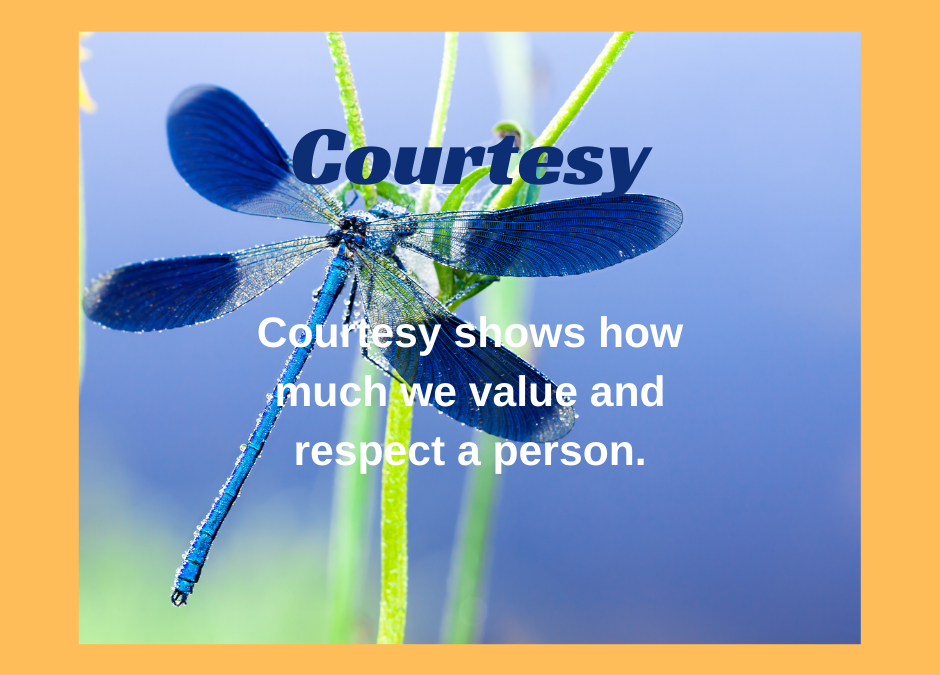Description
Courtesy is the virtue of showing kindness, respect, and thoughtfulness in our interactions with others. It reflects an understanding that every individual has value and deserves to be treated with dignity. When we practice courtesy, we communicate with words and actions that express consideration. Whether it’s through a warm greeting, listening attentively, or using polite language, courtesy demonstrates that we care about how others feel and how they experience the world.
In all walks of life—at home, at work, or in public spaces—courtesy softens our interactions and fosters mutual respect. It’s more than just good manners; it’s a conscious effort to create positive, harmonious connections. We build trust and goodwill by making requests instead of demands and offering help or support with grace.
Courtesy is particularly essential in our closest relationships, where it can sometimes be easy to overlook the importance of kindness. In those moments, offering courtesy is a powerful way to reaffirm the value we place on those we love, deepening our bonds through simple acts of respect and care.
Ultimately, courtesy reflects how much we appreciate others. It has the power to elevate our personal and shared experiences, creating a more compassionate and respectful world.
Affirmations for Courtesy
1. I treat others with kindness and respect in every interaction.
This encourages a mindset of valuing others, leading to more thoughtful words and actions.
2. I listen fully when others speak, without interrupting.
Active listening shows that you care about what others are saying, strengthening respectful communication.
3. I greet everyone warmly and sincerely.
A friendly greeting sets the tone for positive interactions and helps others feel appreciated.
4. I choose my words carefully, aiming to uplift rather than criticize.
Thoughtful speech fosters a positive environment and reduces the likelihood of misunderstandings.
5. I make requests politely, never expecting others to comply.
Politeness in requests shows humility and respect for others’ autonomy and time.
6. I acknowledge and appreciate the efforts of others, no matter how small.
Expressing gratitude reinforces the value of each person’s contributions, nurturing mutual respect.
7. I give people space to express their ideas, even when I disagree.
Respecting different perspectives fosters open and respectful dialogue, a key aspect of courtesy.
8. I avoid rushing interactions and take time to show others they are important.
This slows down busy moments, ensuring that interactions are meaningful and not dismissives.
9. I offer help when I see someone in need, without waiting to be asked.
Anticipating others’ needs is a proactive form of courtesy, showing empathy and care.
10. I remain calm and gracious, even in stressful or difficult situations.
Staying composed helps defuse tension, modeling respectful behavior in challenging moments.
Quotes
“Courtesy is the root of human excellence. It is by acting with propriety and courtesy toward others that we bring harmony to society and show our respect for the dignity of every person.” — Confucius
“Nothing is so strong as gentleness, nothing so gentle as real strength.” — St. Francis de Sales
“Life is not so short but that there is always time enough for courtesy.” — Ralph Waldo Emerson
Courtesy In Family Life
Courtesy in family life is the practice of treating each other with kindness, respect, and consideration. For parents and children alike, it means being thoughtful in how we speak and act, creating an atmosphere of harmony and mutual appreciation. Courtesy begins with simple acts—saying “please” and “thank you,” listening when someone is speaking, and offering help without being asked.
For parents, courtesy involves modeling respectful behavior, showing their children that treating others with dignity is important, even during difficult moments. It means speaking to children with patience, valuing their thoughts and feelings, and encouraging them to do the same with others. This helps children learn to navigate their relationships with respect and empathy.
For children, courtesy is shown by being polite, using kind words, and being mindful of how their actions affect others in the family. It’s about sharing, taking turns, and listening when someone else has something to say. These small gestures create a positive environment where everyone feels valued and respected.
Ultimately, courtesy in family life fosters deeper connections and a sense of peace, making the home a place where each member feels appreciated and understood. It helps build strong, loving relationships that are based on mutual respect and kindness.
Balancing Courtesy
Courtesy, when practiced in balance, becomes a powerful force for fostering kindness, respect, and harmony in family life. It creates an environment where every family member feels valued and understood. However, other virtues must complement courtesy to ensure it remains authentic and does not lead to insincerity, overaccommodation, or neglect of personal needs.
-
-
-
Honesty: Honesty ensures that courtesy is grounded in truth, preventing it from becoming insincere or overly superficial.
-
Assertiveness: Assertiveness helps balance courtesy by encouraging individuals to speak their needs and boundaries respectfully, without fear of conflict.
-
Confidence: Confidence allows family members to practice courtesy without compromising their self-esteem or values, ensuring mutual respect.
-
Justice: Justice ensures that courtesy is extended fairly to all family members, avoiding favoritism or neglect.
-
Humility: Humility tempers courtesy by keeping it genuine and free from pride or the need for recognition.
-
Patience: Patience allows courtesy to persist even during challenging times, ensuring thoughtful interactions.
-
Resilience: Resilience helps prevent courtesy from becoming over-accommodation by encouraging firmness in the face of adversity.
-
Clarity: Clarity supports courtesy by promoting transparent communication, avoiding misunderstandings masked by politeness.
-
Compassion: Compassion ensures that courtesy is rooted in genuine care and understanding, not mere obligation.
-
Detachment: Detachment prevents courtesy from leading to people-pleasing behaviors by fostering healthy emotional independence.
-
-
Balancing courtesy with other virtues is essential for creating a family environment that values both respect and authenticity. When parents and children practice courtesy in harmony with honesty, assertiveness, and compassion, it nurtures relationships built on trust and mutual care. By maintaining this balance, families can thrive as places of love, growth, and meaningful connection.
Joe is a husband, father, grandfather, author, speaker, educator, course creator, and parent/family coach.
He helps parents develop unity, find clarity, communicate, and develop consistency in their parenting with the Four C’s of Successful Families. You can find his work on social media.
In addition, the Four C’s newsletter is enjoyed by many as it encourages parents to self-care, build their relationships with their partners, and raise their children.
And he loves to golf!

